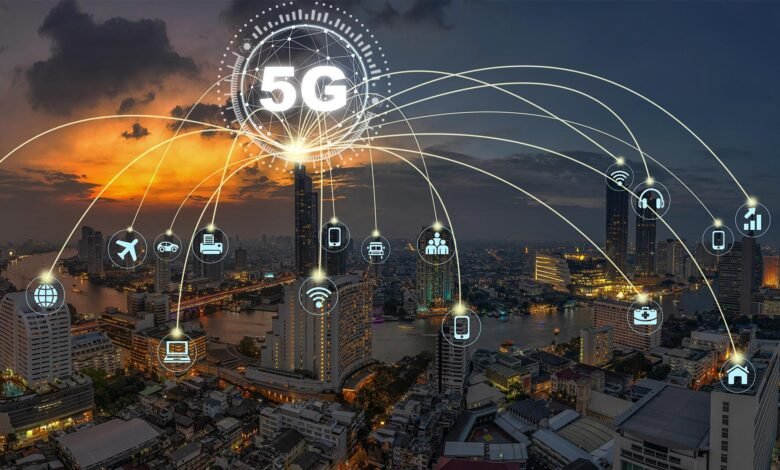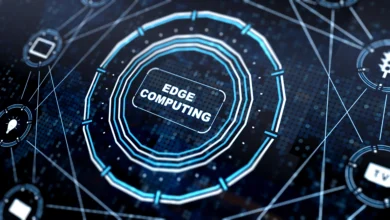How 5G Technology Enables Advanced AI Applications
Discover how 5G technology enables advanced AI applications through ultra-low latency, edge computing, and real-time processing for smart cities.

The convergence of 5G technology and artificial intelligence represents one of the most significant technological breakthroughs of our time. As we advance into an increasingly connected world, the symbiotic relationship between 5G networks and AI applications is reshaping industries, transforming user experiences, and unlocking unprecedented possibilities for innovation. This revolutionary combination is not merely an incremental improvement; it’s a paradigm shift that enables real-time decision-making, ultra-responsive applications, and intelligent automation on a global scale.
Fifth-generation wireless technology provides the critical infrastructure foundation that advanced AI applications require to function optimally. With its ultra-low latency capabilities, massive bandwidth, and enhanced network reliability, 5G enables AI to process data at the edge, reducing response times from milliseconds to microseconds. This technological synergy facilitates the deployment of sophisticated machine learning algorithms, computer vision systems, and predictive analytics across diverse sectors, including healthcare, manufacturing, transportation, and smart city development.
The impact of 5G technology on AI applications extends far beyond faster internet speeds. It creates an ecosystem where edge computing, Internet of Things (IoT) devices, and real-time data processing converge to deliver intelligent solutions that were previously impossible. From autonomous vehicles navigating complex urban environments to smart healthcare systems providing instant diagnostics, the integration of 5G and artificial intelligence is revolutionizing how we interact with technology and process information.
How 5G technology enables advanced AI applications is crucial for businesses, developers, and technology leaders who want to harness the full potential of these converging technologies. This comprehensive exploration will examine the technical foundations, practical applications, and transformative benefits that emerge when 5G networks and AI systems work together to create the intelligent, connected world of tomorrow.
The Foundation 5G Technology and Its AI-Enabling Features
Ultra-Low Latency: The Game-Changer for Real-Time AI
5G technology’s most significant contribution to advanced AI applications lies in its ultra-low latency capabilities. Traditional 4G networks typically exhibit latencies of 50-100 milliseconds, which creates substantial delays for time-sensitive AI applications. In contrast, 5G networks achieve latencies as low as 1 millisecond, enabling real-time AI processing that can respond to events almost instantaneously.
This dramatic reduction in network latency is particularly crucial for AI applications that require immediate responses, such as autonomous vehicle navigation, industrial automation, and emergency response systems. When AI algorithms can process and respond to data within milliseconds, it opens possibilities for applications that demand split-second decision-making, such as collision avoidance in connected cars or real-time fraud detection in financial transactions.
The ultra-low latency characteristic of 5G technology also enhances the performance of distributed AI systems, where multiple AI models work collaboratively across different network nodes. This capability enables sophisticated multi-agent AI systems that can coordinate complex tasks in real-time, from managing smart grid operations to orchestrating drone swarms for search and rescue missions.
Massive Bandwidth and Network Capacity
5G networks deliver unprecedented bandwidth capabilities, with theoretical speeds reaching up to 20 Gbps – approximately 100 times faster than 4G networks. This massive increase in network capacity directly benefits AI applications that require continuous data streaming, such as computer vision systems, natural language processing applications, and real-time analytics platforms.
The enhanced bandwidth allows AI systems to process larger datasets more efficiently, enabling more sophisticated machine learning models to operate in real-time environments. High-definition video analytics, augmented reality applications, and immersive AI experiences become practical when supported by 5G’s robust data transmission capabilities.
Furthermore, the increased network capacity supports the simultaneous operation of multiple AI applications without performance degradation. This capability is essential for smart city implementations, where thousands of AI-powered sensors and devices must communicate concurrently to manage traffic, monitor air quality, optimize energy consumption, and enhance public safety.
Network Slicing for AI Application Optimization
One of 5G technology’s most innovative features is network slicing, which creates dedicated virtual networks optimized for specific AI applications. This capability allows network operators to allocate resources dynamically, ensuring that critical AI systems receive priority access to bandwidth, processing power, and storage resources.
Network slicing enables the creation of specialized environments tailored to different AI application requirements. For instance, autonomous vehicle networks can receive ultra-low latency slices, while IoT sensor networks might utilize high-capacity, energy-efficient slices optimized for machine learning data collection and analysis.
This granular control over network resources ensures that AI applications can maintain consistent performance levels regardless of network congestion or competing demands. Network slicing also enhances security by isolating AI workloads in dedicated network segments, reducing the risk of data breaches and ensuring compliance with privacy regulations.
Edge Computing and AI: A Perfect Partnership Enabled by 5G

Bringing AI Processing Closer to Data Sources
Edge computing represents a fundamental shift in how AI applications process and analyze data. Instead of sending all information to centralized cloud servers, edge computing brings AI processing capabilities directly to network edges, closer to where data is generated. 5G technology serves as the crucial enabler for this distributed architecture, providing the high-speed, low-latency connectivity required for edge AI systems to function effectively.
The integration of 5G and edge computing eliminates the traditional bottleneck of data transmission to remote cloud servers. AI models deployed at edge locations can process video streams, sensor data, and user interactions locally, delivering results within milliseconds. This approach is particularly beneficial for computer vision applications, where processing high-resolution video streams in real-time requires substantial computational resources and minimal latency.
Edge AI systems powered by 5G connectivity enable new categories of applications that were previously impossible due to latency constraints. Augmented reality applications, real-time language translation, and instant image recognition become seamlessly integrated into user experiences when AI processing occurs at the network edge with 5G providing the necessary connectivity infrastructure.
Distributed AI Intelligence Across Multiple Edge Nodes
5G technology enables the creation of distributed AI networks where intelligence is spread across multiple edge computing nodes. This distributed approach allows AI applications to scale dynamically, allocating processing resources based on demand and optimizing performance across the entire network infrastructure.
The 5G network architecture supports seamless communication between edge nodes, enabling collaborative AI systems that can share knowledge, distribute workloads, and coordinate responses across multiple locations. This capability is particularly valuable for smart city applications, where AI systems managing traffic, utilities, and public services must work together to optimize overall urban operations.
Distributed AI intelligence also enhances system resilience and reliability. If one edge node experiences issues, AI workloads can be automatically redistributed to other nodes within the 5G network, ensuring continuous service availability. This fault-tolerance capability is crucial for mission-critical AI applications in healthcare, transportation, and public safety sectors.
Reduced Data Transfer and Enhanced Privacy
Edge AI processing enabled by 5G technology significantly reduces the amount of data that must be transmitted across networks. Instead of sending raw sensor data or video streams to central servers, edge AI systems process information locally and transmit only relevant insights, alerts, or processed results. This approach dramatically reduces bandwidth consumption and improves overall network efficiency.
The privacy benefits of edge AI processing are substantial. Sensitive personal data, medical information, and proprietary business data can remain at edge locations, with only anonymized insights or aggregated results shared across the broader network. 5G’s secure communication protocols ensure that data transmission between edge nodes and central systems maintains the highest security standards.
This privacy-preserving approach to AI processing addresses growing concerns about data protection and regulatory compliance. 5G-enabled edge AI systems can implement advanced encryption, federated learning techniques, and differential privacy methods to protect sensitive information while still enabling sophisticated AI applications to deliver valuable insights and services.
Real-World Applications: How 5G Transforms AI Implementation
Smart Cities and Urban Intelligence
Smart cities represent one of the most comprehensive applications of 5G-enabled AI technology. Urban environments generate vast amounts of data from traffic sensors, security cameras, environmental monitors, and citizen interactions. 5G networks provide the connectivity backbone that allows AI systems to process this information in real-time, creating intelligent urban ecosystems that respond dynamically to changing conditions.
Traffic management systems powered by 5G and AI can analyze vehicle flow patterns, predict congestion, and optimize traffic light timing in real-time. Computer vision algorithms process feeds from thousands of cameras simultaneously, identifying accidents, monitoring parking availability, and enhancing public safety through automatic incident detection. The ultra-low latency of 5G networks ensures that traffic optimization decisions can be implemented immediately, reducing congestion and improving urban mobility.
Environmental monitoring applications leverage 5G-connected IoT sensors and AI analytics to track air quality, noise levels, and energy consumption across cities. Machine learning algorithms identify pollution patterns, predict environmental changes, and trigger automated responses such as adjusting building ventilation systems or alerting authorities to potential health hazards. This real-time environmental intelligence enables cities to proactively address sustainability challenges and improve the quality of life for residents.
Public safety applications benefit significantly from 5G-enabled AI systems. Facial recognition systems, crowd monitoring algorithms, and predictive policing models can process information from multiple sources simultaneously, identifying potential security threats and coordinating emergency responses. The high bandwidth and low latency of 5G networks enable security personnel to access AI-powered insights instantly, improving response times and enhancing overall urban security.
Autonomous Vehicles and Intelligent Transportation
Autonomous vehicles represent perhaps the most demanding application of 5G-enabled AI technology. Self-driving cars must process enormous amounts of sensory data, make split-second decisions, and coordinate with other vehicles and infrastructure elements in real-time. 5G technology provides the critical communication infrastructure that enables autonomous vehicle AI systems to function safely and efficiently.
Vehicle-to-everything (V2X) communication powered by 5G networks allows autonomous vehicles to share information about road conditions, traffic patterns, and potential hazards with other vehicles, infrastructure systems, and traffic management centers. AI algorithms process this shared information to optimize routing decisions, coordinate lane changes, and prevent accidents through predictive analysis of traffic scenarios.
The ultra-low latency capabilities of 5G technology are essential for autonomous vehicle safety systems. When AI systems detect potential collision scenarios, they must communicate warnings and coordinate avoidance maneuvers within milliseconds. Traditional communication networks cannot support these timing requirements, making 5G connectivity a prerequisite for safe autonomous vehicle deployment.
Fleet management applications also benefit from 5G-enabled AI systems. Machine learning algorithms analyze vehicle performance data, predict maintenance needs, and optimize routes for entire fleets of autonomous vehicles. This capability enables transportation companies to reduce operational costs, improve service reliability, and minimize environmental impact through intelligent fleet optimization.
Industrial Automation and Smart Manufacturing
Smart manufacturing environments leverage 5G technology to enable AI applications that optimize production processes, predict equipment failures, and enhance quality control. Industrial IoT sensors connected through 5G networks provide real-time data about machine performance, environmental conditions, and product quality, enabling AI systems to make immediate adjustments to manufacturing processes.
Predictive maintenance applications use 5G-connected sensors and machine learning algorithms to monitor equipment health continuously. AI models analyze vibration patterns, temperature variations, and operational parameters to predict when machines require maintenance, preventing unexpected breakdowns and optimizing maintenance schedules. The real-time data transmission capabilities of 5G networks ensure that maintenance predictions are based on the most current information available.
Quality control systems powered by 5G and computer vision can inspect products at full production speeds, identifying defects and inconsistencies that human inspectors might miss. AI algorithms process high-resolution images and sensor data in real-time, making accept/reject decisions within milliseconds and automatically adjusting manufacturing parameters to prevent defective products.
Robotic automation systems benefit significantly from 5G-enabled AI capabilities. Industrial robots equipped with AI processing can adapt to changing production requirements, coordinate with other robots, and respond to unexpected situations without human intervention. The low latency and high reliability of 5G networks enable these AI-powered robots to work safely alongside human workers in collaborative manufacturing environments.
Healthcare Innovation and Medical AI

Telemedicine platforms enhanced with AI diagnostics can provide expert medical consultations to remote locations. 5G connectivity enables high-definition video consultations while AI systems analyze patient symptoms, review medical histories, and assist healthcare providers in making accurate diagnoses. This capability is particularly valuable for underserved rural communities and emergency medical situations.
Surgical robotics applications leverage 5G networks to enable remote surgery and AI-assisted surgical procedures. Robotic surgical systems equipped with AI guidance can perform precise procedures while surgeons operate from remote locations through 5G-enabled telepresence systems. The ultra-low latency requirements for surgical applications make 5G connectivity essential for safe and effective remote surgical procedures.
Medical imaging applications benefit from 5G’s high bandwidth capabilities, enabling AI systems to process and analyze medical images in real-time. Machine learning algorithms can identify potential health issues in CT scans, MRIs, and X-rays within seconds, providing healthcare providers with immediate insights that improve diagnostic accuracy and patient outcomes.
Technical Advantages: How 5G Amplifies AI Capabilities
Enhanced Data Processing Speed and Efficiency
5G technology fundamentally transforms how AI systems access and process data by providing unprecedented data transfer speeds and network efficiency. The dramatic increase in bandwidth allows AI applications to work with larger datasets, more complex models, and higher-resolution inputs without experiencing the bottlenecks that limit performance in traditional network environments.
Machine learning algorithms benefit significantly from 5G’s enhanced data processing capabilities. Neural networks can access training data more rapidly, enabling faster model updates and real-time learning scenarios. Deep learning applications that require continuous access to large datasets, such as natural language processing and computer vision systems, experience substantial performance improvements when operating over 5G networks.
The improved data processing efficiency also enables more sophisticated AI models to operate in production environments. Transformer-based language models, generative AI systems, and complex reinforcement learning algorithms that were previously limited to research environments can now be deployed in real-world applications thanks to 5G’s data transmission capabilities.
Real-time streaming analytics applications particularly benefit from 5G technology’s data processing enhancements. AI systems can analyze continuous data streams from IoT devices, social media feeds, financial markets, and sensor networks without the delays and interruptions that characterize lower-bandwidth networks. This capability enables AI applications to respond to emerging trends and anomalies as they occur, rather than working with outdated information.
Improved Scalability and Resource Allocation
5G networks provide the scalability infrastructure necessary for AI applications to grow and adapt to changing demands. The network slicing capabilities of 5G technology enable dynamic resource allocation, ensuring that AI systems receive appropriate bandwidth, processing power, and storage resources based on their specific requirements and current workload demands.
Distributed AI architectures benefit significantly from 5G’s scalability features. AI workloads can be distributed across multiple edge computing nodes, cloud servers, and hybrid environments, with 5G networks providing seamless connectivity between all components. This distributed approach enables AI applications to scale horizontally, adding processing capacity as needed without redesigning the entire system architecture.
The ability to scale AI resources dynamically is particularly valuable for applications with variable demand patterns. E-commerce recommendation systems, content delivery networks, and social media platforms can automatically adjust their AI processing capabilities based on user activity, traffic patterns, and computational requirements. 5G technology ensures that these scaling operations occur transparently, maintaining consistent user experiences regardless of system load variations.
Multi-tenant AI environments also benefit from 5G’s resource allocation capabilities. Multiple AI applications can share network and computing resources efficiently, with 5G networks providing quality-of-service guarantees that ensure each application receives appropriate performance levels. This shared resource approach reduces costs while maintaining the performance isolation necessary for mission-critical AI systems.
Enhanced Security and Privacy Protection
5G technology implements advanced security protocols that provide enhanced protection for AI applications and the sensitive data they process. Network-level encryption, authentication mechanisms, and secure communication channels ensure that AI systems can exchange information safely, even when operating across public networks and untrusted environments.
Edge AI processing enabled by 5G networks significantly improves privacy protection by reducing the amount of sensitive data that must be transmitted across networks. Personal information, proprietary business data, and confidential medical records can remain at edge locations, with only processed results and anonymized insights shared with central systems. This approach minimizes privacy risks while enabling sophisticated AI applications to provide valuable services.
Federated learning systems benefit particularly from 5G’s security enhancements. Multiple AI models can collaborate and share knowledge without exchanging raw training data, preserving privacy while improving overall model performance. 5G networks provide the secure communication infrastructure necessary for these distributed learning systems to function effectively across multiple organizations and geographic locations.
Zero-trust security architectures are more practical to implement with 5G-enabled AI systems. Every device, user, and application can be continuously authenticated and monitored, with AI-powered security systems analyzing behavior patterns and detecting potential threats in real-time. The low latency and high bandwidth capabilities of 5G networks ensure that these security operations do not impact application performance or user experiences.
Challenges and Solutions in 5G-AI Integration
Infrastructure Requirements and Deployment Complexity
The integration of 5G technology with advanced AI applications presents significant infrastructure challenges that organizations must address to realize the full benefits of these converging technologies. 5G networks require extensive infrastructure investments, including new base stations, fiber optic connections, and edge computing facilities. The complexity of deploying this infrastructure while maintaining compatibility with existing systems creates substantial technical and financial challenges for organizations.
Network coverage remains a critical challenge for 5G-enabled AI applications. While 5G networks offer exceptional performance within coverage areas, the technology’s reliance on higher frequency bands results in shorter transmission ranges compared to 4G networks. This coverage limitation can create performance gaps for AI applications that require consistent connectivity across large geographic areas or in rural environments.
Edge computing deployment presents additional complexity challenges. Organizations must determine optimal locations for edge computing nodes, balance processing capabilities with cost considerations, and ensure that edge AI systems can operate reliably in diverse environmental conditions. The distributed nature of edge AI infrastructure also complicates maintenance, updates, and security management across multiple deployment locations.
Solutions to these infrastructure challenges include hybrid network approaches that combine 5G connectivity with existing 4G and WiFi networks to ensure comprehensive coverage. Progressive deployment strategies allow organizations to implement 5G-enabled AI applications in phases, starting with high-value use cases and expanding coverage over time. Standardized edge computing platforms and containerized AI applications can simplify deployment and management across diverse infrastructure environments.
Cost Considerations and Return on Investment
The implementation of 5G-enabled AI systems requires substantial upfront investments in network infrastructure, edge computing hardware, and AI development platforms. Organizations must carefully evaluate the costs and benefits of these investments, particularly when existing 4G networks and cloud-based AI systems may appear to meet current requirements adequately.
Total cost of ownership calculations for 5G-AI systems must consider not only initial deployment costs but also ongoing operational expenses, maintenance requirements, and technology refresh cycles. 5G equipment and edge computing infrastructure may have different lifecycle patterns compared to traditional IT systems, complicating long-term cost planning and budget allocation decisions.
AI development costs can be substantial, particularly for organizations developing custom machine learning models and AI applications optimized for 5G environments. The specialized skills required for 5G-AI integration may necessitate significant investments in training existing staff or hiring additional expertise, adding to the overall project costs.
Strategies for managing 5G-AI implementation costs include phased deployment approaches that focus on high-impact use cases with clear return-on-investment metrics. Shared infrastructure models and as-a-service platforms can reduce upfront costs while providing access to 5G-enabled AI capabilities. Public-private partnerships and government incentive programs may also help offset deployment costs for organizations implementing 5G-AI systems with broader societal benefits.
Integration with Legacy Systems

Most organizations operate extensive legacy systems that must continue functioning while 5G-enabled AI applications are implemented. Integration complexity arises from differences in data formats, communication protocols, and processing architectures between legacy systems and modern 5G-AI platforms. Ensuring seamless interoperability while maintaining system security and performance presents significant technical challenges.
Data migration and synchronization between legacy systems and 5G-enabled AI platforms requires careful planning and execution. AI systems may require access to historical data stored in legacy formats, while legacy applications may need to consume insights generated by modern AI models. Maintaining data consistency and accuracy across these diverse systems adds complexity to integration projects.
Security considerations become more complex when integrating legacy systems with 5G-AI platforms. Legacy systems may lack the advanced security features required for 5G environments, creating potential vulnerabilities that could compromise the entire integrated system. Organizations must implement additional security measures to protect legacy components while ensuring that these measures do not impede AI system performance.
Gradual migration strategies can help organizations manage legacy system integration challenges. API gateways and middleware platforms can provide translation layers between legacy and modern systems, enabling gradual functionality migration while maintaining operational continuity. Hybrid architectures allow organizations to leverage 5G-enabled AI capabilities for new applications while maintaining critical legacy systems until they can be replaced or upgraded.
Future Trends and Emerging Opportunities
6G Development and Next-Generation AI Capabilities
While 5G technology continues its global deployment, research into sixth-generation (6G) wireless networks is already underway, promising even more advanced capabilities for AI applications. 6G networks are expected to deliver terabit-per-second data rates, sub-millisecond latency, and near-perfect reliability, creating possibilities for AI applications that are currently beyond reach.
Holographic communications and extended reality (XR) applications will become practical with 6G networks, enabling AI systems to create immersive experiences that blend physical and digital environments seamlessly. AI-powered avatars and virtual assistants could interact with users through holographic displays, creating new paradigms for human-computer interaction and AI-assisted services.
Brain-computer interfaces may become viable for widespread use with 6G-enabled AI systems. The combination of ultra-low latency, massive bandwidth, and AI processing capabilities could enable direct neural interfaces that translate thoughts into digital commands, revolutionizing accessibility technologies and creating new categories of AI-enhanced human capabilities.
Autonomous AI agents operating across 6G networks could possess unprecedented autonomy and intelligence, capable of making complex decisions and executing tasks with minimal human oversight. These advanced AI systems could manage entire smart cities, coordinate global supply chains, and provide personalized services that adapt continuously to user needs and preferences.
Industry-Specific Innovation Opportunities
Healthcare sector opportunities for 5G-enabled AI applications extend far beyond current telemedicine and diagnostic applications. Precision medicine platforms could analyze real-time biometric data from wearable devices, genetic information, and environmental factors to provide personalized treatment recommendations and predict health issues before symptoms appear.
Agriculture industry applications of 5G-AI technology include precision farming systems that monitor crop health, soil conditions, and weather patterns in real-time. AI-powered drones and autonomous farming equipment could optimize planting, irrigation, and harvesting operations while minimizing environmental impact and maximizing yield efficiency.
Energy sector innovations include smart grid systems that use 5G-connected sensors and AI analytics to optimize energy distribution, predict equipment failures, and integrate renewable energy sources seamlessly. AI-powered energy management systems could balance supply and demand in real-time while minimizing costs and environmental impact.
Entertainment industry opportunities include immersive gaming experiences, interactive media content, and AI-generated entertainment that adapts to user preferences in real-time. 5G networks enable cloud gaming platforms where AI systems can generate game content dynamically, creating unique experiences for each player.
Global Connectivity and Digital Inclusion
5G technology and AI applications have the potential to address global digital inclusion challenges by providing advanced technological capabilities to underserved communities. Satellite-based 5G networks could extend AI-enabled services to remote areas where traditional infrastructure deployment is impractical or cost-prohibitive.
Educational applications of 5G-enabled AI systems could provide personalized learning experiences to students regardless of their geographic location. AI tutoring systems, language learning platforms, and virtual classrooms could deliver high-quality education to areas with limited access to qualified teachers and educational resources.
Economic development opportunities arise when 5G-AI technologies enable small businesses and entrepreneurs in developing regions to access global markets. AI-powered translation services, e-commerce platforms, and digital payment systems operating over 5G networks could create new economic opportunities and reduce barriers to international trade.
Environmental monitoring and climate change mitigation efforts could benefit from global 5G-AI deployments. AI systems analyzing data from 5G-connected environmental sensors worldwide could provide unprecedented insights into climate patterns, pollution sources, and ecosystem health, enabling more effective global responses to environmental challenges.
More Read: How 5G Technology Enables Advanced AI Applications
Conclusion
The convergence of 5G technology and artificial intelligence represents a transformative force that is reshaping industries, enabling new applications, and creating unprecedented opportunities for innovation across the global economy. 5G networks provide the critical infrastructure foundation that advanced AI applications require, offering ultra-low latency, massive bandwidth, and enhanced reliability that make real-time, intelligent systems practical for widespread deployment.
From smart cities and autonomous vehicles to industrial automation and healthcare innovation, the integration of 5G and AI technologies is creating intelligent, responsive systems that improve efficiency, enhance safety, and provide personalized experiences. While challenges related to infrastructure deployment, cost considerations, and legacy system integration must be addressed, the potential benefits of 5G-enabled AI applications far outweigh these obstacles.
As 5G networks continue to expand globally and AI technologies become more sophisticated, we can expect to see even more innovative applications that leverage this powerful combination to solve complex problems, create new business models, and improve the quality of life for people worldwide. The future of technology lies in the continued evolution and integration of 5G and AI systems, promising a more connected, intelligent, and responsive world for generations to come.








